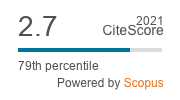GENERALIZED CAPUTO-KATUGAMPOLA FOR SOLVING FUZZY FRACTIONAL HEAT EQUATION
Abstract
The fuzzy theory is investigated in this paper and the frac-
tional derivative with two parameters is used to construct the solution
of the fuzzy fractional heat equation. We devised a method for comput-
ing a semi-analytical solution to a fuzzy fractional-order heat equation
based on the Optimal Homotopy Asymptotic Method (OHAM). This
method helps us to overcome the obstacles and constraints that other
approaches impose whereby it is used to construct powerful and efficient
ways of finding the solutions to the heat equation with more accuracy,
minimal effort, and iterations. The Mittag–Leffler (ML) kernels which
include two parameters Eσ
ν,ξ (λ, s) are utilized to define the fractional
derivative. A broad approach to dealing with this type of situation is
presented. Several examples are provided to validate the outcome, which
is then contrasted with the precise solution to demonstrate the effective-
ness and feasibility of the proposed method. The results are presented
in terms of tables and figures
Downloads
Published
How to Cite
Issue
Section
License
Copyright (c) 2023 Results in Nonlinear Analysis

This work is licensed under a Creative Commons Attribution 4.0 International License.



